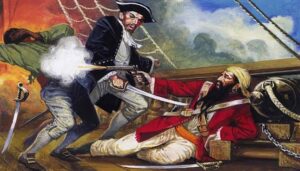Doctor Curmudgeon® Yo-Ho!
By Diane Batshaw Eisman, M.D. FAAP Doctor Eisman is in Family Practice in Aventura, Florida with her partner, Dr. Eugene Eisman, an internist/cardiologist
His name was Edward Teach. Or some say it was Edward Thatch. But he was known and feared as the pirate, Blackbeard.
Born around 1680 in Bristol, England, he terrorized the shipping lanes of the Caribbean and North America in 1717 and 1718.
In May of 1718 his flagship went aground at Beaufort Inlet, North Carolina. Blackbeard and a few of his crew managed their getaway on a smaller vessel.
It was not until 1996 that the wreck of his flagship, Queen Anne’s Revenge, was discovered and archaeologists could begin their excavation and study of the artifacts.
There were plenty of medical instruments aboard. Blackbeard intended to keep his crew in good physical condition. Pirating was not an easy career choice.
Queen Anne’s Revenge had been a French slaver and Blackbeard captured three French surgeons along with their medical equipment.
Among these finds were a urethral syringe. With all those pirates around, and lots of Syphilis, it must have seen frequent use.
Linda Carnes-McNaughton, an archeologist and curator who worked on the excavation project said that chemical analysis showed the syringe to have contained mercury.
So, if the Syphilis didn’t kill you, you could die of mercury poisoning!
Rectal pumps, called clysters were found. Carnes-McNaughton said they were likely used so that fluid could be more rapidly absorbed by pumping. These pumps may have been used to quickly treat dehydration, constipation or dysentery. Depending on the symptoms of the crew member, they would carry a concoction of wine, vinegar, tobacco, brandy, cork ash or chamomile.
And where would medical treatment of the time be without an instrument for bloodletting?
A device called a porringer was among the artifacts. It was also known as a bleeding bowl. Bloodletting was considered a great therapeutic tool to cure a patient of a variety of illnesses. Physicians at that time believed it was also a great diagnostic tool for giving clues as to what was happening in the body.
Brass set screws were discovered, commonly used as tourniquets to control blood loss during amputations.
Not all the archeological finds were gruesome. A plain old brass mortar and pestle was found, useful for grinding up medications. And there was a silver needle and remnants of scissors for surgery and suturing. Containers used to preserve salves called galley pots, were discovered. There were sets of nesting weights, for measuring exact weight of medications. Most likely state of the art for that time.
As Dr. Linda Carnes-McNaughton said at a meeting of the Society for Historical Archaeology, this was “the era of mystical medical treatments.”
Indeed it was.
Dr. Curmudgeon suggests “Bitter Medicine”, Dr. Eugene Eisman’s story of his experiences–from the humorous to the intense—as a young army doctor serving in the Vietnam War.
Bitter Medicine by Eugene H. Eisman, M.D. –on Amazon
Doctor Curmudgeon® is Diane Batshaw Eisman, M.D., a physician-satirist. This column originally appeared on SERMO, the leading global social network for doctors.
SERMO www.sermo.com
Click Here to Order Boxing Interviews Of A Lifetime By “Bad” Brad Berkwitt


